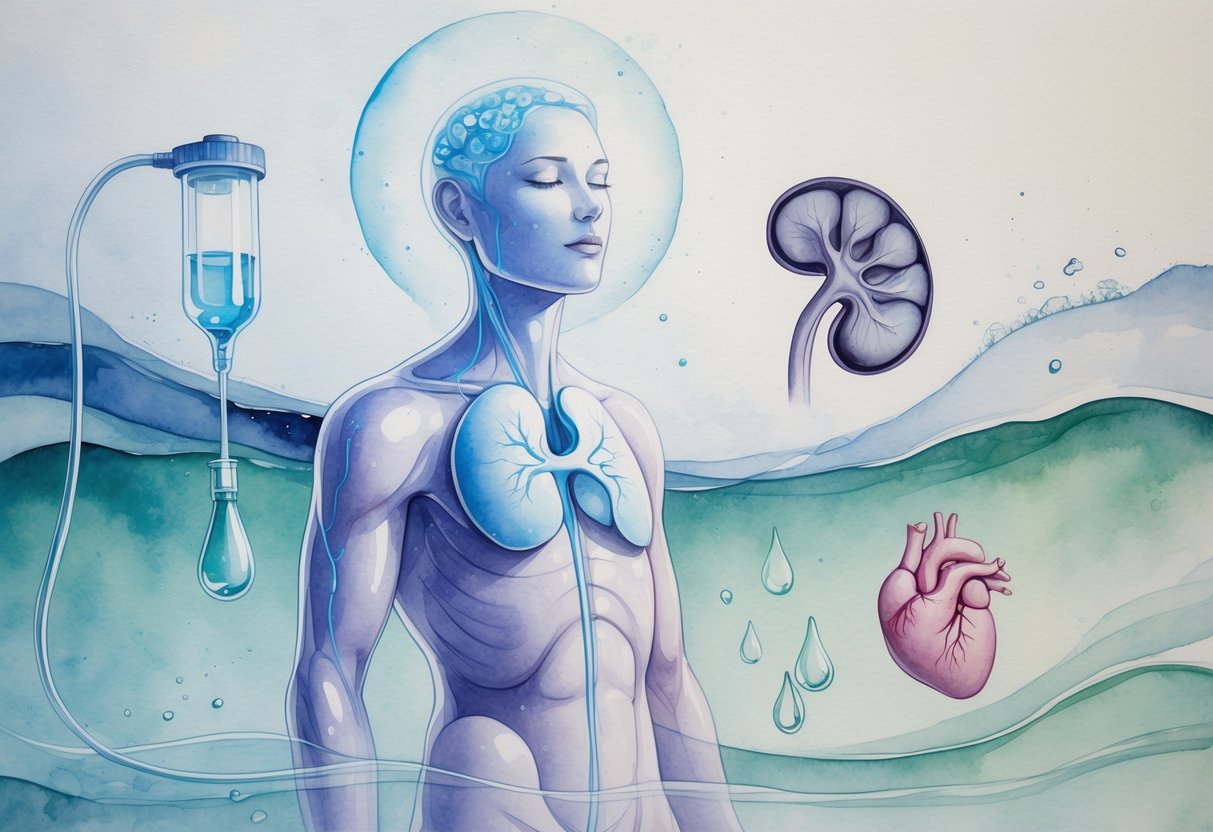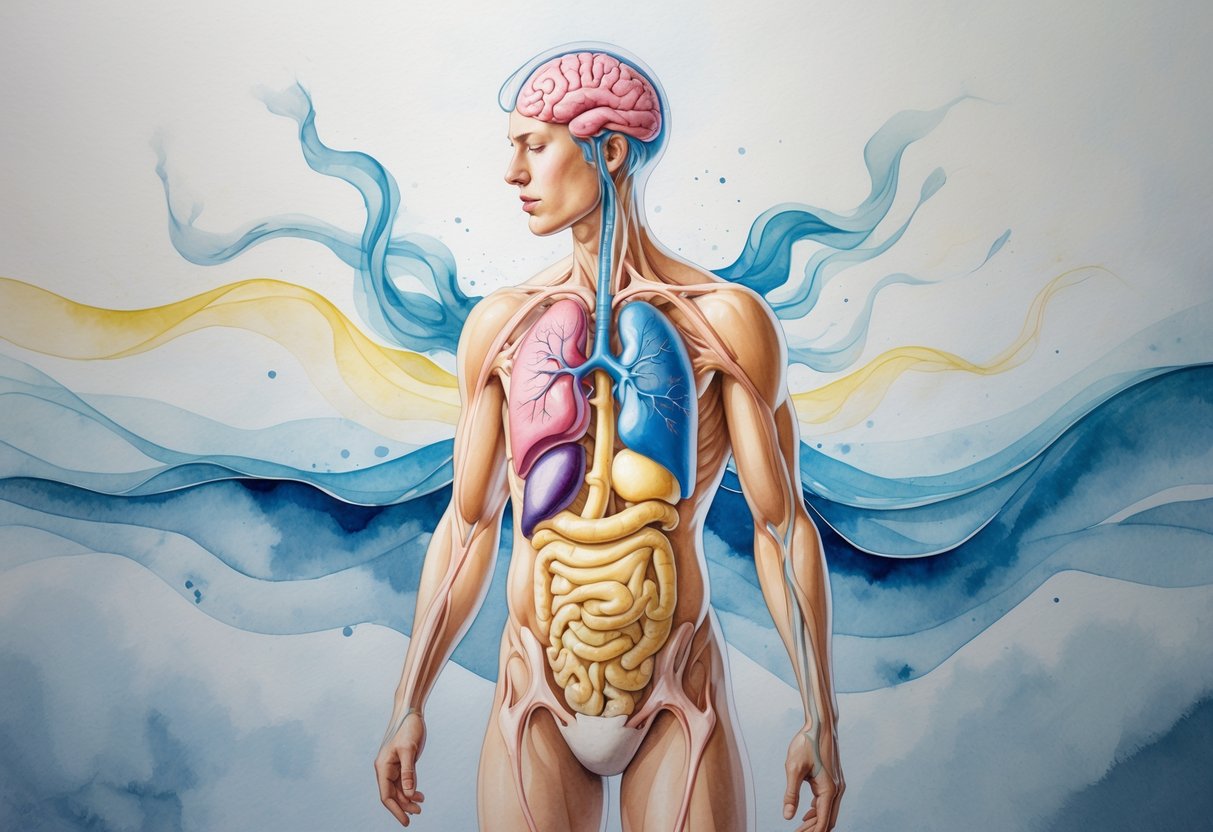Low sodium in the blood, called hyponatremia, can cause serious health problems that affect how your brain and body work. When sodium levels drop too low, people experience symptoms like confusion, fatigue, muscle cramps, headaches, and nausea, and severe cases can lead to seizures or even coma.

Hyponatremia occurs when the body contains too little sodium[1] for the amount of fluid it holds. This happens for many reasons, including drinking too much water, taking certain medications, or having heart, kidney, or liver problems. The condition affects people of all ages but poses greater risks for older adults.
Understanding the warning signs and causes of low sodium helps people get treatment before the condition becomes dangerous. Low sodium levels can be life-threatening[2] if left untreated, making it important to recognize symptoms early and seek medical care when needed.
Key Takeaways
- Low sodium causes brain dysfunction symptoms like confusion, fatigue, and muscle cramps that can progress to seizures
- Common causes include drinking too much water, certain medications, and diseases affecting the heart, kidneys, or liver
- Treatment involves restricting fluids and addressing underlying causes, with severe cases requiring emergency medical care
Understanding Low Sodium (Hyponatremia)

Sodium acts as a vital electrolyte that helps control water balance in the body, while hyponatremia occurs when blood sodium levels drop below the normal range of 135-145 milliequivalents per liter.
What Is Sodium and Its Role in the Body
Sodium is an essential electrolyte that the body needs to work properly. It helps control the amount of water inside and outside cells.
This electrolyte plays a key role in nerve function. Sodium helps send signals between nerve cells throughout the body.
Key functions of sodium include:
- Maintaining proper fluid balance
- Supporting muscle contractions
- Enabling nerve signal transmission
- Regulating blood pressure
The kidneys control how much sodium stays in the body. They filter sodium from the blood and either keep it or remove it through urine.
When sodium levels change, it affects how water moves in and out of cells. This process is critical for normal body function.
Definition of Hyponatremia
Hyponatremia is when the amount of sodium in blood is too low[1]. This condition disrupts the normal balance of water and sodium in the body.
The condition happens in two main ways. The body either holds too much water or loses too much sodium.
Common causes include:
- Drinking excessive amounts of water
- Vomiting or diarrhea
- Heart, liver, or kidney disease
- Certain medications
- Heavy sweating without replacing electrolytes
Low sodium can also develop from health problems that disrupt fluid balance[3]. These include conditions like SIADH, which affects hormone levels.
The brain is most affected by hyponatremia. Brain cells swell when sodium levels drop too low.
Normal vs. Low Blood Sodium Levels
Normal blood sodium levels range from 135 to 145 milliequivalents per liter (mEq/L). Blood tests measure these levels accurately.
Sodium level categories:
| Blood Sodium Level | Classification |
|---|---|
| 135-145 mEq/L | Normal |
| 130-134 mEq/L | Mild hyponatremia |
| 125-129 mEq/L | Moderate hyponatremia |
| Below 125 mEq/L | Severe hyponatremia |
Mild hyponatremia may cause few symptoms. People might feel tired or confused.
Moderate to severe low sodium levels cause more serious problems. Symptoms can include headaches, muscle weakness, and seizures[4].
Severe hyponatremia can be life-threatening[2]. Brain swelling can lead to coma or death if not treated quickly.
Doctors check sodium levels through simple blood tests. Regular monitoring helps catch problems early.
Common Symptoms of Low Sodium

Low sodium symptoms start mild but can become dangerous if left untreated. Early signs include fatigue and headaches, while severe cases can cause seizures and brain swelling.
Early Signs and Mild Symptoms
The first signs of sodium deficiency[5] often appear gradually and may seem like common health issues. Many people experience fatigue and feel unusually tired during daily activities.
Headaches are one of the most common early symptoms. These headaches may feel dull or throbbing and don’t always respond well to pain medication.
Muscle problems often develop next. People may notice muscle weakness or cramping, especially in their arms and legs. The muscles may feel heavy or difficult to control.
Digestive symptoms frequently occur alongside other signs. Nausea can make eating difficult, while some people also experience vomiting. These symptoms can make the sodium problem worse by causing more fluid loss.
Mental changes may be subtle at first. People might feel irritable or have trouble focusing. Some experience mood swings or feel more anxious than usual.
Lethargy often accompanies other symptoms, making people feel sluggish or unmotivated throughout the day.
Severe and Life-Threatening Symptoms
When sodium levels drop very low, hyponatremia symptoms become dangerous[4] and require immediate medical attention. The brain is most affected by severe cases.
Confusion becomes more pronounced as sodium levels continue falling. People may have trouble thinking clearly or remembering basic information. They might seem disoriented or unable to follow simple instructions.
Seizures can occur when sodium drops to dangerous levels. These may start as small muscle twitches but can progress to full-body convulsions. Seizures from low sodium are a medical emergency.
Brain swelling happens because low sodium causes water to move into brain cells. This swelling increases pressure inside the skull and can cause severe damage.
The most serious cases can lead to coma. When the brain swells too much, people may lose consciousness completely. Without treatment, this can result in permanent brain damage or death.
Other severe symptoms include extreme muscle weakness where people cannot walk or stand. Breathing may become difficult if the muscles that control breathing are affected.
Primary Causes of Low Sodium Levels

Low sodium levels develop when the body retains too much water compared to sodium or loses sodium faster than it can replace it. Medical conditions that affect major organs and certain medications are the main reasons this happens.
Medical Conditions Affecting Sodium Balance
Several serious health problems can disrupt how the body manages sodium and water balance. Heart failure[1] makes the kidneys hold onto too much water, which dilutes sodium levels in the blood.
Kidney disease and kidney failure[6] prevent the body from removing excess water properly. The kidneys cannot filter blood correctly, causing fluid buildup.
Liver disease[6] creates problems with protein production and fluid regulation. When the liver does not work well, fluid leaks into tissues and dilutes sodium.
Syndrome of inappropriate antidiuretic hormone (SIADH) causes the body to release too much of a hormone that makes kidneys keep water. This condition can happen with lung infections, brain injuries, or certain cancers.
An underactive thyroid slows down many body processes, including how kidneys handle water and sodium. People with severe thyroid problems often develop low sodium levels.
Diabetes insipidus affects how the body makes or responds to hormones that control water balance, though this more commonly causes high sodium levels.
Medications and Drug-Induced Hyponatremia
Many common medications can lower sodium levels by affecting how kidneys work or changing hormone levels. Diuretics[6] are water pills that help remove excess fluid but also flush out sodium through urine.
Antidepressants, especially older types called tricyclics and newer ones called SSRIs, can trigger the release of hormones that make kidneys hold water. This dilutes sodium in the bloodstream.
Certain pain medications, particularly some prescription drugs, affect hormone production in ways that disturb sodium balance. Narcotic pain relievers can stimulate the release of antidiuretic hormone.
Other medications that may cause low sodium include some seizure drugs, chemotherapy treatments, and drugs used for heart conditions. Patients taking multiple medications face higher risks of developing sodium imbalances.
Who Is Most at Risk for Low Sodium?

Certain groups face higher chances of developing hyponatremia due to age-related changes and existing health conditions[1]. Older adults and people with chronic illnesses need extra attention for sodium level monitoring.
Risk Factors by Age and Health Status
Age-Related Risks
Adults over 65 face the highest risk for low sodium levels. Their kidneys work less efficiently at maintaining proper fluid balance.
Younger adults typically develop hyponatremia only during extreme conditions. Long-distance runners and athletes who drink excessive water during events show increased risk.
Medical Conditions
People with these health problems have higher chances of developing low sodium:
- Heart failure – reduces the body’s ability to process fluids properly
- Kidney disease – impairs sodium regulation and fluid removal
- Liver disease – disrupts hormone balance that controls sodium levels
- Adrenal disorders – affects hormones that manage electrolyte balance
Medications
Several common medications increase hyponatremia risk. Diuretics cause the body to lose both water and sodium through increased urination.
Antidepressants and seizure medications can trigger SIADH, which disrupts fluid balance[3]. Pain medications and some blood pressure drugs also raise risk levels.
Hyponatremia in Older Adults
Why Seniors Face Higher Risk
Older adults develop low sodium levels more frequently than younger people[7]. Their bodies contain less total water, making small changes more significant.
Aging kidneys lose their ability to concentrate urine effectively. This makes it harder to maintain proper sodium-to-water ratios.
Common Triggers in Seniors
Hospital stays increase hyponatremia risk in older patients. IV fluids and medications can quickly disrupt sodium balance.
Many seniors take multiple medications that affect sodium levels. Water pills, antidepressants, and pain relievers create combined risks.
Complications
Falls become more likely when older adults have low sodium. Confusion and muscle weakness from hyponatremia[2] increase accident risks.
Recovery takes longer in older patients. Their bodies need more time to restore proper electrolyte balance safely.
How Low Sodium Is Diagnosed

Doctors use blood tests to measure sodium levels[4] and confirm hyponatremia. They also review medical history and perform physical exams to find the underlying cause.
When to Seek Medical Attention
People should seek immediate medical care if they experience severe symptoms like seizures, confusion, or muscle weakness. These signs may indicate dangerously low sodium levels that require urgent treatment.
Mild symptoms like headaches, nausea, or fatigue also warrant medical evaluation. Early diagnosis helps prevent complications from worsening hyponatremia.
Athletes and elderly individuals face higher risks for sodium imbalances. They should monitor for symptoms after intense exercise or during illness.
Emergency symptoms include:
- Seizures or convulsions
- Severe confusion or altered mental state
- Loss of consciousness
- Severe muscle weakness
Diagnostic Blood and Urine Tests
A basic blood test measures the exact sodium level in the bloodstream. Normal sodium levels range from 135 to 145 milliequivalents per liter.
Blood sodium levels below 135 mEq/L confirm hyponatremia[1]. Levels below 120 mEq/L indicate severe cases requiring immediate treatment.
Urine tests help doctors determine why sodium levels dropped. These tests measure how much sodium the kidneys are removing from the body.
Additional blood tests may check kidney function, hormone levels, and electrolyte balance. These results help identify underlying conditions causing the sodium imbalance.
Common diagnostic tests:
- Comprehensive metabolic panel
- Urine sodium concentration
- Urine osmolality
- Thyroid function tests
Medical History and Physical Examination
Doctors ask detailed questions about recent symptoms, medications, and medical conditions. They want to know about vomiting, diarrhea, excessive sweating, or increased fluid intake.
Current medications play a key role in diagnosis. Diuretics, antidepressants, and pain medications can all lower sodium levels.
The physical examination checks for signs of dehydration or fluid retention. Doctors look at blood pressure, heart rate, and signs of swelling.
Medical history helps identify conditions like heart failure, kidney disease, or liver problems[3] that commonly cause low sodium. Previous episodes of hyponatremia are also important clues.
Key history questions include:
- Recent fluid intake patterns
- Current prescription medications
- Chronic medical conditions
- Recent illness or exercise habits
Treatment Strategies for Low Sodium

Treatment for hyponatremia involves raising sodium levels[8] through immediate medical care and long-term management approaches. The specific approach depends on how severe the condition is and what caused it.
Immediate Actions and Emergency Care
Emergency treatment focuses on quickly raising dangerously low sodium levels in the blood. Doctors typically use intravenous sodium solutions to correct severe cases.
IV Fluid Treatment Getting IV fluids is a common treatment[1] for moderate to severe hyponatremia. Medical professionals carefully monitor the rate of sodium correction to prevent brain swelling.
Saline solutions containing higher sodium concentrations help restore proper electrolyte balance. The infusion rate must be controlled because raising sodium too quickly can cause serious complications.
Medication Adjustments Healthcare providers review all current medications that might contribute to low sodium. Thiazide medications can cause sodium levels to drop[9], especially in older adults.
Doctors may need to substitute different medications or adjust dosages. This step prevents further sodium loss while other treatments work to restore normal levels.
Long-Term Management and Prevention
Long-term hyponatremia treatment addresses the underlying causes and prevents future episodes. The approach varies based on what initially caused the sodium imbalance.
Fluid Restriction Limiting water intake helps manage hyponatremia[1] when the body holds too much water relative to sodium. Patients typically need to track their daily fluid consumption.
Healthcare providers set specific fluid limits based on individual needs. This strategy works best for people whose low sodium comes from drinking too much water.
Managing Underlying Conditions Heart, liver, kidney and brain diseases commonly cause hyponatremia[1]. Proper treatment of these conditions helps prevent sodium levels from dropping again.
Regular blood tests monitor sodium levels and medication effectiveness. Patients with chronic conditions need ongoing medical supervision to maintain proper electrolyte balance.
Dietary Changes Diet changes and electrolyte replacement[4] support long-term sodium management. Some patients may need to increase their salt intake under medical guidance.
Working with healthcare providers ensures dietary modifications match individual medical needs. This prevents overcorrection while maintaining healthy sodium levels.
Complications and Prognosis of Untreated Low Sodium

Untreated low sodium can be dangerous[2], especially when levels drop quickly. The brain faces immediate risks from swelling, while prolonged sodium deficiency creates lasting health problems.
Short-Term Dangers
Acute hyponatremia poses immediate threats[9] to brain function. When sodium drops rapidly, brain cells absorb excess water and swell.
Brain Swelling Effects:
- Confusion and sluggishness appear first
- Muscle twitches develop as condition worsens
- Seizures occur with severe brain swelling
- Coma can result from untreated cases
The speed of sodium loss determines symptom severity. Rapid drops create more dangerous situations than gradual changes over days or weeks.
Older adults face higher risks[9] of severe symptoms. Their brains are more sensitive to sodium changes than younger people.
Death becomes possible when brain swelling goes untreated. Emergency medical care becomes necessary once seizures or coma develop.
Long-Term Health Impact
Chronic hyponatremia develops gradually[10] over days or weeks. The body partially adapts to lower sodium levels, but problems persist.
Ongoing Complications Include:
- Frequent falls from balance problems
- Reduced cognitive function
- Increased bone fracture risk
- Muscle weakness and fatigue
People with chronic conditions face repeated episodes. Heart failure, liver disease, and kidney problems[1] often cause recurring sodium imbalances.
Treatment becomes more complex with long-term cases. Simple fluid restriction may not prevent future episodes in chronic patients.
The prognosis improves significantly with proper medical management. Early treatment prevents most serious complications from developing.
Frequently Asked Questions

Low sodium affects people differently based on age, health conditions, and treatment methods. Recovery times vary widely depending on how severe the condition becomes and what causes it in the first place.
What are the potential causes of hyponatremia in the elderly?
Older adults face higher risks for low sodium due to age-related changes in kidney function and hormone levels. Their bodies process water and sodium less efficiently than younger people.
Many elderly people take medications that can lower sodium levels in the blood[9], especially thiazide diuretics. These drugs remove more sodium than water from the body.
Heart failure, kidney disease, and liver problems become more common with age. These conditions can cause the body to retain too much water, which dilutes sodium levels.
Dehydration from not drinking enough fluids or losing fluids through illness affects older adults more severely. Their sense of thirst often decreases with age.
How can low sodium levels be effectively treated?
Treatment depends on how severe the low sodium is and what caused it. Doctors may recommend diet changes and electrolyte replacement with an IV[4] for more serious cases.
Mild cases often improve by limiting water intake and adjusting medications. Patients may need to reduce or stop certain drugs that lower sodium levels.
Severe cases require hospital treatment with careful monitoring. Doctors give sodium through IV fluids but must raise levels slowly to prevent brain damage.
Treating underlying conditions like heart failure or kidney disease helps prevent sodium levels from dropping again. This may involve multiple medications and lifestyle changes.
What is the typical recovery timeline for someone with hyponatremia?
Recovery time varies greatly depending on how low sodium levels dropped and how quickly treatment begins. Most people fully recover if they’re treated right away[1].
Mild cases may improve within a few days of treatment. Patients often feel better once sodium levels start rising toward normal ranges.
Severe cases can take weeks to fully resolve. The brain needs time to adjust as sodium levels slowly increase.
People with chronic conditions that caused the low sodium may need ongoing monitoring. Their recovery depends on how well doctors can control the underlying health problems.
What are the symptoms indicating dangerously low sodium levels?
Early warning signs include headaches, nausea, and feeling confused or restless. These symptoms often get worse as sodium levels continue to drop.
More serious symptoms include confusion, seizures, weakness, and muscle spasms[4]. People may also experience severe headaches and changes in mental state.
Extremely low sodium can cause coma or death if left untreated. The brain swells as it tries to balance the lack of sodium in blood.
Athletes who drink too much water during long events may develop these symptoms quickly. They need immediate medical attention to prevent serious complications.
How is low sodium linked to cancer-related conditions?
Cancer treatments like chemotherapy can damage the kidneys and affect how they process sodium. Some cancer drugs also cause nausea and vomiting, leading to sodium loss.
Certain cancers produce hormones that make the body hold onto too much water. This dilutes sodium levels even when people eat normal amounts of salt.
Cancer patients often have poor appetites and may not eat enough sodium-containing foods. Pain medications and other treatments can also affect sodium balance.
Brain tumors can disrupt the hormones that control water and sodium balance. These patients need careful monitoring of their blood chemistry during treatment.
Can hyponatremia have long-term health implications?
Repeated episodes of low sodium can affect brain function over time. Some people experience ongoing problems with memory and thinking skills.
Severe cases that develop quickly can cause permanent brain damage if not treated fast enough. The brain tissue may not fully recover from swelling.
People with chronic conditions face higher risks of developing low sodium again. They need regular blood tests and careful medication management.
Bone health may suffer in people who have frequent episodes of low sodium. The condition can affect how the body uses calcium and other minerals.
References
- Hyponatremia: Causes, Symptoms, Diagnosis & Treatment. https://my.clevelandclinic.org/health/diseases/17762-hyponatremia Accessed October 23, 2025
- Hyponatremia: Why Low Sodium Levels Are Dangerous. https://www.uhhospitals.org/blog/articles/2024/11/hyponatremia-why-low-sodium-levels-are-dangerous Accessed October 23, 2025
- Low sodium can also develop from health problems that disrupt fluid balance. https://www.verywellhealth.com/hyponatremia-low-sodium-2488674 Accessed October 23, 2025
- Hyponatremia (Low Blood Sodium): Symptoms, Causes, Treatments. https://www.medicinenet.com/hyponatremia/article.htm Accessed October 23, 2025
- 7 Hidden Signs of a Sodium Deficiency You Shouldn't Ignore — Seeking Health. https://www.seekinghealth.com/blogs/education/7-hidden-signs-of-a-sodium-deficiency-you-shouldnt-ignore-4 Accessed October 23, 2025
- Hyponatremia - Endocrine and Metabolic Disorders. https://www.merckmanuals.com/professional/endocrine-and-metabolic-disorders/electrolyte-disorders/hyponatremia Accessed October 23, 2025
- There doesn't seem to be anything here.. https://www.msdmanuals.com/home/hormonal-and-metabolic-disorders/electrolyte-balance/hyponatremia-low-level-of-sodium-in-blood Accessed October 23, 2025
- Hyponatremia | Endocrinology. https://www.mercy.com/health-care-services/endocrinology/conditions/hyponatremia Accessed October 23, 2025
- Hyponatremia (Low Level of Sodium in the Blood) - Hormonal and Metabolic Disorders. https://www.msdmanuals.com/home/hormonal-and-metabolic-disorders/electrolyte-balance/hyponatremia-low-level-of-sodium-in-the-blood Accessed October 23, 2025
- Attention Required!. https://www.news-medical.net/health/Hyponatremia-Complications.aspx Accessed October 23, 2025
